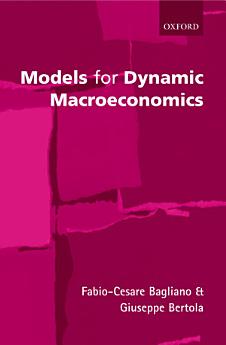Models for Dynamic Macroeconomics
feb. 2004 · OUP Oxford
Carte electronică
296
Pagini
family_home
Eligibilă
info
reportEvaluările și recenziile nu sunt verificate Află mai multe
Despre această carte electronică
Dynamic Approaches to Macroeconomics provides the advanced student with key methodological tools for the dynamic analysis of a core selection of macroeconomic phenomena, including consumption and investment choices, employment and unemployment outcomes, and economic growth. The technical treatment of these tools will enable the student to handle current journal literature, while not assuming any particular familiarity with advanced analytical tools or mathematical notions. As these tools are introduced, they are related to particular applications to illustrate their use. Chapters are linked by various formal and substantive threads. Discrete-time optimization under uncertainty, introduced in Chapter 1, is motivated and discussed by applications to consumption theory, with particular attention to empirical implementation. Chapter 2 focuses on continuous-time optimization techniques, and discusses the relevant insights in the context of partial-equilibrium investment models. Chapter 3 revisits many of the previous chapters' formal derivations with applications to dynamic labour demand, in comparison to optimal investment models, and characterizes labor market equilibrium when not only individual firms' labor demand, but also individual labor supply by workers, is subject to adjustment costs. Chapter 4 proposes broader applications of methods introduced in the previous chapters and studies continuous-time equilibrium dynamics of representative agent economies, featuring both consumption and investment choices, with applications to long-run growth frameworks of analysis. Chapter 5 illustrates the role of decentralized trading in determining aggregate equilibria, and characterizes aggregate labor market dynamics in the presence of frictional unemployment. Chapters 4 and 5 pay particular attention to strategic interactions and externalities: even when each agent correctly solves his or her individual dynamic problem, modern microfounded macroeconomic models recognize that macroeconomic equilibrium need not have unambiguously desirable properties. By bridging the gap between undergraduate economics and modern microfounded macroeconomic research, this book will be of interest to graduate students in economics, and as a technical reference for economic researchers.
Despre autor
Fabio-Cesare Bagliano is currently Professor of Economics in the Faculty of Economics, University of Tunrin, having previously held other teaching positions in Turin and Teramo (Italy); in 1987-90 he held a research position at the Centre for Economic Performance (London School of Economics and Political Science). He is Associate Editor of Giornale degli Economisti e Annali di Economia and has published in the Journal of Banking and Finance, the European Economic Review, the Journal of Macroeconomics, and other academic journals and books. Giuseppe Bertola is currently Professor of Economic Policy in the Faculty of Political Science, University of Turin. He has previously held other teaching positions in Turin and visiting positions in various places, including Assistant Professor and Assistant Director of the International Finance Section, Princeton University. He is a Managing Editor of Economic Policy and Condirettore of Giornale degli Economisti e Annali di Economia. His work is published in the Review of Economic Studies, American Economic Review, the European Economic Review, and other academic journals and books.
Evaluează cartea electronică
Spune-ne ce crezi.
Informații despre lectură
Smartphone-uri și tablete
Instalează aplicația Cărți Google Play pentru Android și iPad/iPhone. Se sincronizează automat cu contul tău și poți să citești online sau offline de oriunde te afli.
Laptopuri și computere
Poți să asculți cărțile audio achiziționate pe Google Play folosind browserul web al computerului.
Dispozitive eReader și alte dispozitive
Ca să citești pe dispozitive pentru citit cărți electronice, cum ar fi eReaderul Kobo, trebuie să descarci un fișier și să îl transferi pe dispozitiv. Urmează instrucțiunile detaliate din Centrul de ajutor pentru a transfera fișiere pe dispozitivele eReader compatibile.




